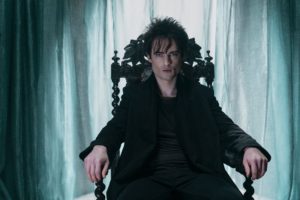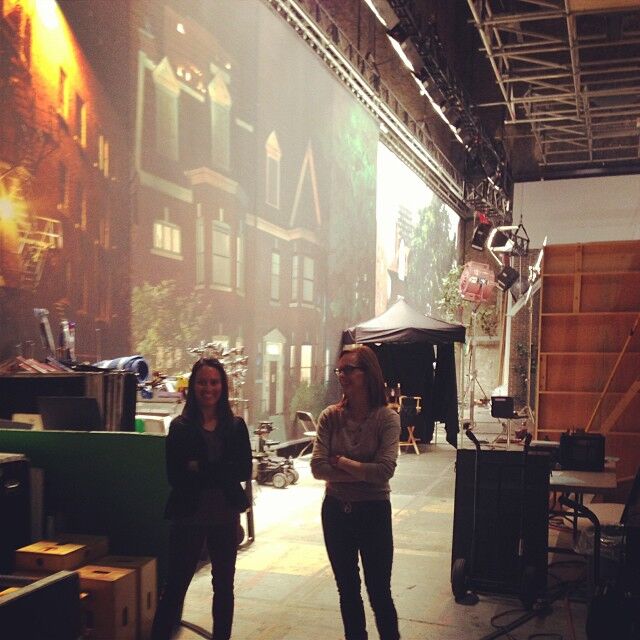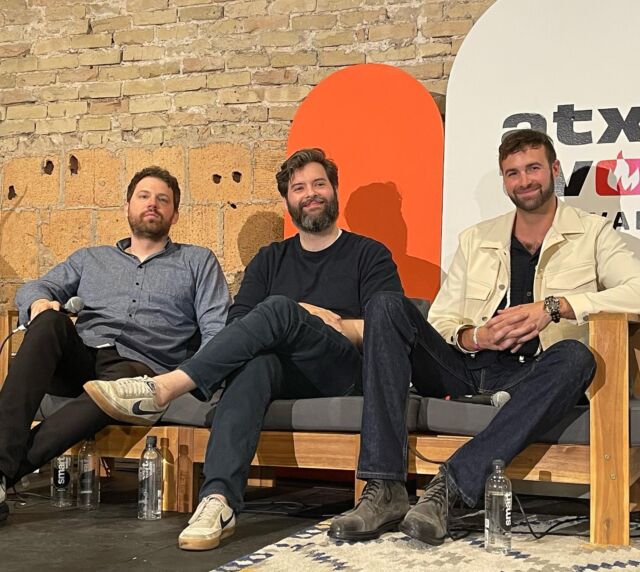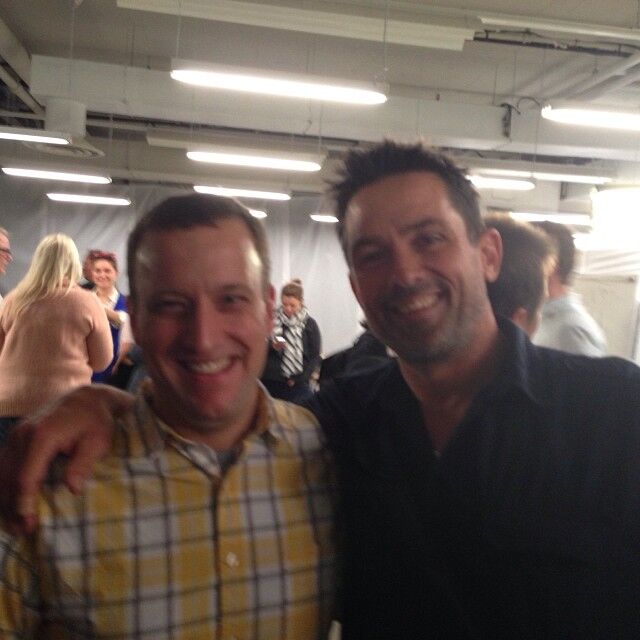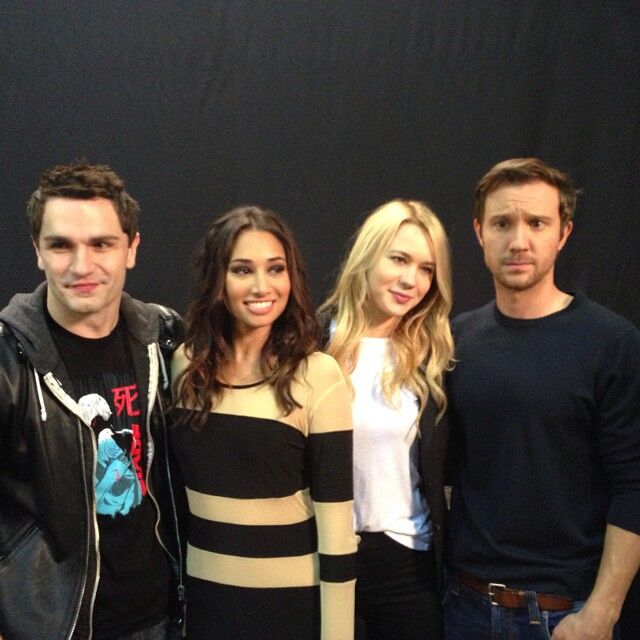Netflix has just launched the first season of The Sandman, an adaptation of Neil Gaiman’s beloved comic book series of the same name.
There is another world that waits for all of us when we close our eyes and sleep — a place called the Dreaming, where The Sandman, Master of Dreams (Tom Sturridge), gives shape to all of our deepest fears and fantasies. But when Dream is unexpectedly captured and held prisoner for a century, his absence sets off a series of events that will change both the dreaming and waking worlds forever. To restore order, Dream must journey across different worlds and timelines to mend the mistakes he’s made during his vast existence, revisiting old friends and foes, and meeting new entities — both cosmic and human — along the way.
At this year’s San Diego Comic-Con, we got to speak with executive producers Neil Gaiman & Allan Heinberg, and stars Gwendoline Christie (“Lucifer”), Boyd Holbrook (“The Corinthian”), Jenna Coleman (“Johanna Constantine”), Tom Sturridge (“Dream”) & Vivenne Archeampong (“Lucienne”). At the press room roundtables, we weren’t allowed to take any photos or videos, but the text of these interviews can be found below:
- Executive Producers Neil Gaiman & Allan Heinberg
- Gwendoline Christie (“Lucifer”)
- Boyd Holbrook (“The Corinthian”)
- Jenna Coleman (“Johanna Constantine”)
- Vivenne Archeampong (“Lucienne”)
- Tom Sturridge (“Dream”)
Executive Producers Neil Gaiman & Allan Heinberg
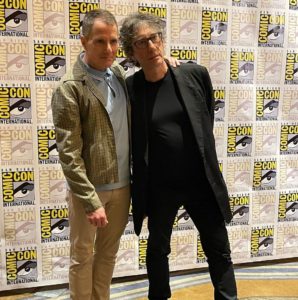 Q: How did you decide how to map out the first season?
Q: How did you decide how to map out the first season?
Gaiman: Mostly, we just did that thing of looking at what we’ve got and going, Season One, that’s probably Nocturnes and The Doll’s House … it was never any more complicated than that. It seemed a perfect introductory place. We went and we borrowed tiny things from Sandman Overture in episode one to set a few things up and we’ve moved a few things around, but those two first volumes seemed like they would perfectly fit our first season.
Q: Can you talk about any additions or changes you might have made from the comics?
Heinberg: Most of the time when we change something, we would do it to expand the story and tell parts of the story that Neil didn’t have the pages to tell, you know, back when he was writing the comic, so things like characters, as as Neil has recently said, being able to set up the serial killers convention much earlier in the series, introducing this trio of serial killers that we then follow into it, weaving their stories in, so especially in Doll’s House. I feel like we made a lot of changes where you get to know Jed more than we were able to get to know Jed in the comic, the serial killers, and we were able to weave those stories together.
Gaiman: It’s mostly … because I had 24 pages an issue, and it was finite. So what’s great is going, Okay, well we’ve got 50 minutes an episode, let’s get the Rose Walker plot running, and let’s get the Jed plot running, and let’s get the serial killer plot running, and they’re all things that happen in The Doll’s House. It’s just in The Doll’s House, we mostly stay with Rose and follow through with her, whereas with this we get to move and see more of what’s going on. So it feels less like we’re changing anything for the sake of changing anything, and mostly it feels like we’re just giving you extra fries with that.
Q: You have graphic novel, and then you have the audio book, and now you have a TV series. What do you like about doing different mediums for this story?
Gaiman: I think what I love about making the comics was that I was doing something nobody had ever done before, and felt like I was actually going into the jungle with a machete going … people have been making novels for hundreds and hundreds of years, but I’m making a comic book that’s a specific thing and nobody’s ever done this thing before. So, succeed or fail, I’m out here on my own, and that was amazing. With the audio, it was the joy of having an infinite budget. Getting all of the actors we could ever dream of because there’s nobody who won’t come out for two hours on an afternoon, and just getting to really do something that was an audio book and bring Sandman to the partially sighted, the people who don’t like or understand comics, or just don’t have the kind of brains that process comics. The blind, bringing it to people who didn’t know if they’d like that kind of thing, but it’s come up on their Audible thing and now they’re driving around listening to Sandman and discovering it’s the thing that they love. For the story, for Netflix, the joy honestly is making it breathe and making people cry, in a good way. Just trying to fill people’s hearts so huge that it’s going to come out of their eyes, making them care, making these characters come alive in front of them, and the knowledge that if we didn’t do it one day, somebody’s gonna do it, and they won’t do it in the way that we’ll do it because we’ll do it as right as we possibly can, and we love it. We care for it, we understand it, so making a TV series that’s as good as we can, for an audience who we don’t know if they’re out there or not. We don’t have to like it or not. But we know that we made something that we love and I’m good with that.
Q: Did you already have in mind potential actors or performers in mind for these characters that have been with you for so long?
Gaiman: with the exception of deciding early on that we were going to get Patton Oswalt to play Matthew? No. I don’t think there was anybody else … we didn’t have an initial dinner and say “Let’s get so and so and so forth”. It was very, very organic. Occasionally, sometimes there would be people who were obvious. A lot of the times we auditioned, get a few auditions in from our casting director and then go, Uh, but that’s not the kind of thing we wanted, but … what about so and so, what about … so there was there was a kind of a lovely process where your casting director sometimes would just—we got Tom Sturridge from Lucinda Syson as one of the first four people she sent us. She auditioned Tom. He was it, and … many thousands of people were seen after Tom, but Tom was it. But a lot of the time, we’d go Well, what about, you know … I’m trying to think of a few people where we didn’t go out to anybody. And there were a brief few, I think, Gilbert and Stephen Fry—
Heinberg: Gwendolyn, Patton. Derek Jacobi was the only person who went after, well, we asked him to play Bill Patterson’s character first. He wasn’t available, and so we asked him back.
Gaiman: … there’s a few people that we went out to and we couldn’t get
Heinberg: Charles Dance was obvious to us. Yeah, we got lucky. And then … we would get these casting tapes. And I’d be very worried about a role like Despair. And then we saw Donna Preston’s tape come in. Again, one of the three or four first people we saw, and the minute I saw Donna’s read I was like that’s — and Neil and I aren’t together, he’s in New Zealand and I’m in London — and he’s having the same experience watching Donna Preston independently. So that happened again and again and again.
Gaiman: There weren’t really, I don’t remember any fights or arguments between me and Alan at all about casting. There would be a couple of places where Alan might say, you know, we really need to get so and so cast and should we settle for this person and I would go I don’t think we’re there yet. And we go out again. But that happened, maybe twice, out of 340 speaking parts. So … the casting process was astounding, and it worked every possible way it could work, and these actors who are up here. Kirby — people talk about casting Death, as if it was the easiest thing in the world. We saw hundreds and hundreds and hundreds of Death auditions. I think Lucinda Syson must have seen thousands. We had supermodels. We had many famous, famous actresses. We had all sorts of people auditioning, and they couldn’t say the lines. Not that they weren’t great actresses, some of them, but those lines didn’t work coming out of those mouths. Or you just didn’t believe that they were actually Tom Sturridge’s big sister who could speak truth to him and he would listen. And that was the key. And we also had to find somebody who, when you meet her, and she says, “You really should look both ways before crossing that street”, you go, “Oh, I love you. I’m so glad you’re here at this moment with me.” And you know hundreds and hundreds of auditions in, we found Kirby, and we talked, and we knew that we had found our Death.
Gwendoline Christie (“Lucifer”)
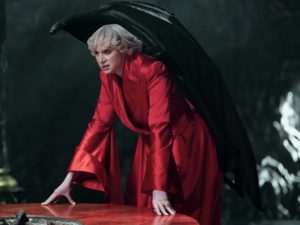
>The Sandman. Gwendoline Christie as Lucifer Morningstar in episode 104 of The Sandman. Cr. Laurence Cendrowicz/Netflix © 2022
Q: What makes your Lucifer different from other iterations?
Christie: What makes mine Lucifer different? Well, to be honest, I was working really hard to absorb the comics, to think about what it was that Neil wanted to say. And to do my best to channel that. I think really probably the difference, or the thing about my Lucifer is that, as I touched upon earlier, this came about at a time when our world as we knew it was changing. And so there have been so many tragic, global crisis that we’ve had to absorb during our time, that I felt that the embodiment of evil was an absence of empathy, and disconnection. And really, what a lifetime of disappointment does to someone. So those are what I focused on. I really listened to what Neil said, because we had so many conversations together about how Lucifer should look. And my partner Giles Deacon worked on my costumes. So we would all meet together over Zoom, and we’d have these conversations, looking at the source material and looking at the script, listening to what they were saying, what I was thinking, and I think we want to do something pretty spectacular. Really, we wanted to do something fabulous. And I wanted the opportunity of—to be lucky enough to be in Game of Thrones for so many years—to play a radically different character. And I wanted to use parts of myself that I’ve never used before in the performances I’ve given, and to tap into something else. And I can’t really say how it’s different. I can only say that, it came absolutely from a place of total collaboration, real, a feeling of responsibility for source material, and also wanting to vent my spleen (laughs).
Q: At what point did you feel comfortable in the character?
Christie: It was, as soon as I read it. As soon as I read it, I felt that I knew what it was, because the great thing about Neil’s work is that it changes you. I think people that read it find themselves in some way changed, whether it transports us in that magical way that it does and takes us through, you know, phantasmagorical journey, or whether it’s a really deep emotional connection about why we lie. I just felt that as soon as I read it, I knew who it was. … I love doing it. … I hope that there can be more to continue to explore this character. But it, the writing, is really strong and scripts. And that’s kind of quite rare as well, when you pick them up, and you’re captivated. I think you kind of see from the trailer as well. They know what they’re doing. … They know what they’re doing. And it’s really honest, the comic books, but it’s really I think it’s very well structured experience narrative, and clearly from Allan Heinberg, someone that has deep respect and love and, and the reason it was such a pleasure to work with him, everyone felt the same way.
Q: Could you talk about the dynamic between Lucifer and Dream?
Christie: Well, I thought about what that could be, I thought about the idea of this. I see ego maniacal bureaucrat ruler, encountering a seemingly less powerful entity. And the landscape of the psychology of those two people, the personality types, and what an intense vibe that they both been throwing off at each other. And the level of undermining, the level of mendacity, of sadism, done with the treachery with a smile on its face, this idea of brittle, evil and how it wants to manipulate. And there is a great pleasure. I found out from playing [that] scene with Tom in a psychological war.
Q: How much time was spent in creating that big scene with Dream?
Christie: So much time, so much time. … It was at least six months worth of talking or starting talking about scenes structured, the scene, how it would look, how it would be — they built those incredible huge sets. They had real fire. It was Jamie Childs who directed them, was real dream, because he had such an easy, genuine attitude, but was very seriously, Okay, let’s go there. And there was at one stage, it was a lighting state where Tom and I both felt like we were hallucinating. It was incredible.
Boyd Holbrook (“The Corinthian”)

The Sandman. Boyd Holbrook as The Corinthian in episode 102 of The Sandman. Cr. Liam Daniel/Netflix © 2022
Q: What sort of inspiration or work did you do to create the character?
Holbrook: I started out just familiarizing myself with the comic books. I knew about them. I read them in high school a couple of— I had never even seen The Doll’s House, so I didn’t know the character. And at first glance, I thought it was this sort of very overly-cocky or just, … very flamboyant character. And it seemed that way. And then as I started reading the actual scripts, I understood that this is a person who just has a second lease on life. Who is was able to, maybe the analogy of a person being in prison and being released and just having the embrace to life, that he can go out and basically suck every last drop of satisfaction out of life as he can because he feels a ticking clock. That was one dimension of the character, so he really enjoys every minute that he’s in the waking world. And he is the fabrication of the creation of your worst nightmare in the dreaming world, but in the waking world, he becomes almost as patron of saints to the serial killers, that he is the leader, almost as a cult figure would would be, so having this power and having all this support was just sort of wealth of knowledge. And I did the combing through serial killers, and finding out that there’s process killing, people kill for the actual adrenaline rush of the all that, then there’s the Jeffrey Dahmers, who are the keeping of the, in the sense that he was so, yearns to have a joyous feeling, a happiness feeling, didn’t feel any of the range of emotions that human beings feel, he can’t do that. So I’ve started interpreting that’s why he’s such an artist in his butchery, to be able to keep all these people that he wouldn’t, it gives him a sensibility that he’s so close that to getting an emotion, of joy or happiness, that the pain or love or anger in his things, that people get a feel they just can’t have that, so it becomes an obsession for him. And over time, he is like, the sharpest knife in the drawer. And it was really just a constant constant evolution of being able to understand something. It’s a very long-winded answer.
Q: Can you talk about The Corinthian’s relationship with Morpheus?
Holbrook: It feels like … Morpheus was the stepfather that I didn’t really ask for. He had given me life, and what a shit life he’s given me, so there’s so much resentment that’s been built up between The Corinthian and Morpheus. That obviously has to come to a head. He knows. I know that my fate is coming. So it just gives me, it almost fuels the fire, and sort of that teen rebellion sort of way. Of just, I’ll show you, and I tried….
Q: Can you talk about the look of the character?
Holbrook: There was just that one Doll’s House comic … when we we sat back and thought about it, there’s a sophistication that would have be acquired over such a long period of time, and an elegance in that, to be able to survive without having any income, just really practical things. And so, a lot of the fashion choices were made through that, and how he would sort of circle amongst people and be able to have his prey. And also, he almost becomes a kind of a connoisseur, a sommelier of everything. So, you imagine the low hanging fruit being acquired in the beginnings, but after a while that becomes old and really tiring after a while, so the art and the game of it all would be, What type of person can I be, What type of can I get, then to work yourself into those rings of society and culture. You have to play the part and I think over time, it’s become him.
Jenna Coleman (“Johanna Constantine”)

The Sandman. (L to R) Eleanor Fanyinka as Rachel, Jenna Coleman as Johanna Constantine in episode 103 of The Sandman. Cr. Liam Daniel/Netflix © 2022>
Q: How did you form this new version of the character?
Coleman: I think I came to it in a good way because … a version of the character was sent to me before I knew who it was. So I had a really instinctive read on purely the writing before I even knew it was Constantine. So that for me was like, I kind of felt instinctively like I knew what to do with it. So I kind of worked backwards. And then I looked at a lot of it, to be honest, I was like, Right, where can you research Latin exorcisms? and … technically went to look at that stuff. And then, I feel like Alan’s version, that he very much wanted the Johanna Constantine to be the upgraded version. And she’s now Excorcits to the Canadian kings, she’s kind of moved up in her in the ranks, so to speak. So I use comic books, but I didn’t look at other other versions of it, because I felt like it was it was so there in the writing that actually I should run with that.
Q: What about the look of the character?
Coleman: There’s a lot of conversation RE: costume, actually, because we went down the road at first, which was much more like the comic book … kind of a lot more masculine as well, and had, what are they called where the trousers are — trench coat, but also like, the suspender belt thing, and so there was this kind of, this real rough around the edges, and then we went with the chicer look, which is like Okay, this is Constantine now, who is earning money, at the top top of her exorcism game. And obviously then it’s really fun playing early Johanna as well in Newcastle and going back to earlier parts of her, at her upper working class roots.
Q: Was there a particular scene or script where you really felt like okay, now know who this character is?
Coleman: I honestly felt like it from the first read … I felt like it was so complex and a lot like the character in terms of this huge, this roguish nurse, using everything is about deflection and using cynicism, wit humor to deflect from the fact that actually inside is quite a tortured wounded, like a lone warrior who doesn’t want to become close to because she’s so scared of hurting anybody else around her, and … being born with a gift, and the cost of that and it being a blessing and a curse. So everything is about armor and armoring up to keep those to not let anybody too close because it hurts too much. And then I think what’s really interesting is actually putting that character in a room with Dream. And the one place Dream can enter is her dreams, which is obviously her at her most vulnerable that she doesn’t let anybody else into. And I really enjoyed that play. And I think what was really interesting actually is in my first scenes with Tom, it was cause he was there with me in the room, but as if he was 1000 places at once at the same time and I don’t know how he did that. But it was like, What creature are you because you’re not, you’re something other and I can’t place you but you intrigue me, and I kind of don’t quite know how to operate with you. So as to as the character dynamic between the two of them it was really, really joyous. And it was a bit of a battle of the egos, but a mutual kinship and admiration, but also a complete stubbornness to admit any fondness towards the other. So it was such fun playing field between them. Yeah, there’s never like me in terms of the script … the gender never came into it because I was like, I know completely who she is, and it makes complete sense. So yeah, it was quite it was very an instinctive thing.
Q: How much input into the character did you have early on?
Coleman: Alan is very, there’s so many stages of that, like me and Tom, it was one of the early first things that we did actually … Tom was at early days of shooting Dream as well … I remember Alan, Neil was in New Zealand, so we just did a read through and with me and Tom, Neil on Zoom and Alan, and then Alan would go away and work and develop the scripts and then on the day, every single line, minute of every scene, Alan was there, so if there was anything dialogue wise that he felt wasn’t working, he would always adapt and change, but Alan was there I say, every single, still molding every single scene as we went.
Q: Will we see any of Constantine’s familiar traits or friends?
Coleman: No smoking—I think that might be … Warner Brothers policy. I might be wrong. But I mean, my voice is low enough as if I’ve been smoking. I’ve dropped my voice a couple of octaves, so we can feel we can feel the cigarettes. One of my favorites, Hattie, from the comic book is [there]. We created those scenes, and it’s such good casting. And so yeah, it’s very, you’ll see. I mean, you’ll literally see those comic book images come to life.
Vivenne Archeampong (“Lucienne”)
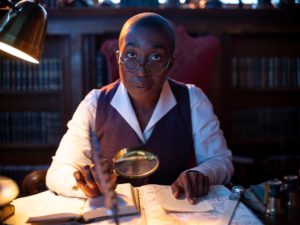
The Sandman. Vivienne Acheampong as Lucienne in episode 109 of The Sandman. Cr. Laurence Cendrowicz/Netflix © 2022>
Q: What is it about Lucienne from the comics that you really liked and incorporated into the character?
Archeampong: I think that from the comics, just this how stoic, still so loyal to Dream, and wanting the best for The Dreaming, and I don’t think that’s changed, that is still very evident in our show. … I think the core of what we see in the comics, and what we have in the show is still there. I think that’s for all of the show. Even though this is an adaptation, and even Neil himself has said that it’s very liberating to adapt to it, you still got the original source material, which is absolutely stunning. It’s gorgeous. It’s beautiful. It’s there. Now we have this TV adaptation, which has evolved a bit and it’s for people to see and then you have Audible as well, which you know, you can lean into it, let your imagination run wild with you. So I think that it’s just great.
Q: Can you talk about the relationship dynamic between Lucienne and Dream?
Archeampong: [It’s a] two partner relationship. I think that for Lucienne, Dream is, he’s difficult. He’s hard work. You know, we see that. But what Tom does so brilliantly in this role as well is he brings a humanity to Dream, and I think that their relationship is so special. She is so loyal to Morpheus, loyal to a fault probably. And I think that she acts as his moral compass a lot. She stepped back, she steps back, she observes, she sees what’s going on, and she tries to advise the best that she can, but she doesn’t want to step on his toes, because he is the boss. I mean, even though some people said that Lucienne is the real boss. You know, I’m just repeating what people are saying. But I think that, again, I don’t want to give any spoilers, but I do think that we see friction in their relationship later on in the episodes because he’s been gone for a long time. And she had to keep this place going. And she’s seen a lot. She’s experienced a lot, she knows how The Dreaming and the entities that reside there are feeling. and I think that for Dream, it’s a big wake up call for him. And it’s interesting to see when things come to—I don’t want to say a head because that feels too strong—but when there was friction within that relationship.
Q: How aware of the series in the books were you before going into the role?
Archeampong: I had heard of The Sandman, but I wasn’t that familiar with it. And then I got an audition to play Unity Kincaid originally, and they were like, “Oh, don’t worry about the age”, and I was like, “Yeah, I’m not gonna worry”. This is very rude, but I want to work, so, and then I got a recall, to play—they didn’t say Lucienne though, because it was all top secret. So I didn’t know, so I got a recall, and I got another recall, and that’s when it was kind of like Sandman. I looked at the comments. I was like, Oh, my God, oh, my God, I need to get this job. I need to get this job because this is one of those jobs that if you don’t get it, I’m watching this thing and I’m gonna be bitter about it. I’m gonna be honest, I don’t bid about, and it was just, so the comics are stunning. I think what they say is incredible. And now having watched it, even if I wasn’t in it, but I’ve seen all the episodes as well. I mean, I think I’ve literally cried in each one. Because it’s just such the things in Neil’s work, are Yeah, it’s fantasy, it’s, you know, flawless. It’s, you know, terrifying. It’s magical, but it’s all about the human condition. There’s lots, there’s desire, there’s love. There’s lots. There’s so much ,and then the fact that it centers around dreaming for me as well, personally, was something that was so special because our unconscious mind speaks to us in our sleep. And for me as well at the time I experienced loss. And I was dreaming about that person. They were coming to me and stuff like that. And I just think it’s fascinating and just having this world that is so comforting. And I just think it’s absolutely stunning. And the characters when you’ve got a character like Death, I mean, I could talk about this for ages, but I just think it’s, I’m a fan now. Basically, I’ve just come into this. I hope that people that are new like me that have come to it, just fall in love with it as much as I have. I just think it’s incredible. And I’m like “I’m in this. I can’t believe it”.
Q: What was it like working on the scenes with characters like Mervyn?
Archeampong: We had a couple, but that was one of my most fun days on set. It was so brilliant. And then you’ve got this raven, so it was like, at one point it was a puppet. And then at one point, it was a real raven. I was like, Is this my life? And then you’ve got massive pumpkin head. And I’m like, okay, fit, and it was it was incredible. So that was lit. I can remember that so vividly. When we filmed those scenes, and I was like, oh my god, this is so amazing. Yeah, it’s great.
Q: What type of character work or preparation did you need to do?
Archeampong: I feel like I’m in drama school over again. … I think that this role in particular I’ve been so lucky because the material, and I keep banging on about it, but it’s so rich. We’ve got so much to work from it’s such a luxury as an actor. So you’ve got the amazing comics, then you’ve got Alan’s adaptation, which again, just made it so easy for me because the character just speaks from that script. I instantly connected with Lucienne when I read it on the page, because it’s so vivid, it’s so well written, it’s so amazing. And then you’ve got Neil, who is just across everything. He is across everything from the glasses to the costume, everything. So what I just had to do as an actor was just take it all in and experience it and be present and be truthful. … But what makes for me as an actor working on it is the truth. And that’s what I think we all do is like Tom is just incredible, incredible working with Tom made me just up my game because he embodies Morpheus and is so detailed in what he’s doing. It’s hard just not to just be bouncing off him. And what does Lucienne want? For The Dreaming to be restored, and for Dream to get his shit together and be be the being that she knows that he should be.
Tom Sturridge (“Dream”)
Q: We know you weren’t familiar with the comics at first, and then you immersed yourself during the submission process. What did you love most about them as you’re trying to get into this character?
Sturridge: The first thing I love about them is that Sandman is a story about stories. And so that there is no singular thing, in the same way that all of us are different, it gives you a part that all of us dream, it gives the opportunity to investigate all of us. … I think my favorite character is Petrefax .. he is a trainee in the Necropolis Litharge where they they train everyone in a different Burial Rites of all the creatures of the universe.
Q: How did you get into this character?
Sturridge:So the first thing is—because the in the opening he’s naked—his physicality was incredibly important because I didn’t speak, there was no voice, and I had to figure out a way to communicate to an audience that this is a member of The Endless, this isn’t a human, and I use the images that are in the comic. But also, I had this idea that he had through millennia of trying to hold in everyone’s, the collective unconsciousness of the universe, it sort of burnt away in his flesh and he’s just, as he is in the comics, sinew and skin, like a panther being shaved. Not like something that we see … not a kind of like muscly guy, like just this kind of pure, contained energy. So what I’m saying is that takes a little while to create, and so I spent months trying to get to that stage physically. Then the voice really was the second thing, and it took me a really long time to figure it out. And it was Neil’s advice that did it, which was he is the voice inside your head, the voice that brings you to sleep, the voice that guides you through your dreams … and not a voice of aggression, or power. It’s the voice I tried to get out, and really also when you look at the comics, and you see that those white capital letters on that black background. I don’t know about you but I do hear, you do read something, you hear something very different too, when you read other characters speaking, and that was just as formative in its own strange subliminal way.

